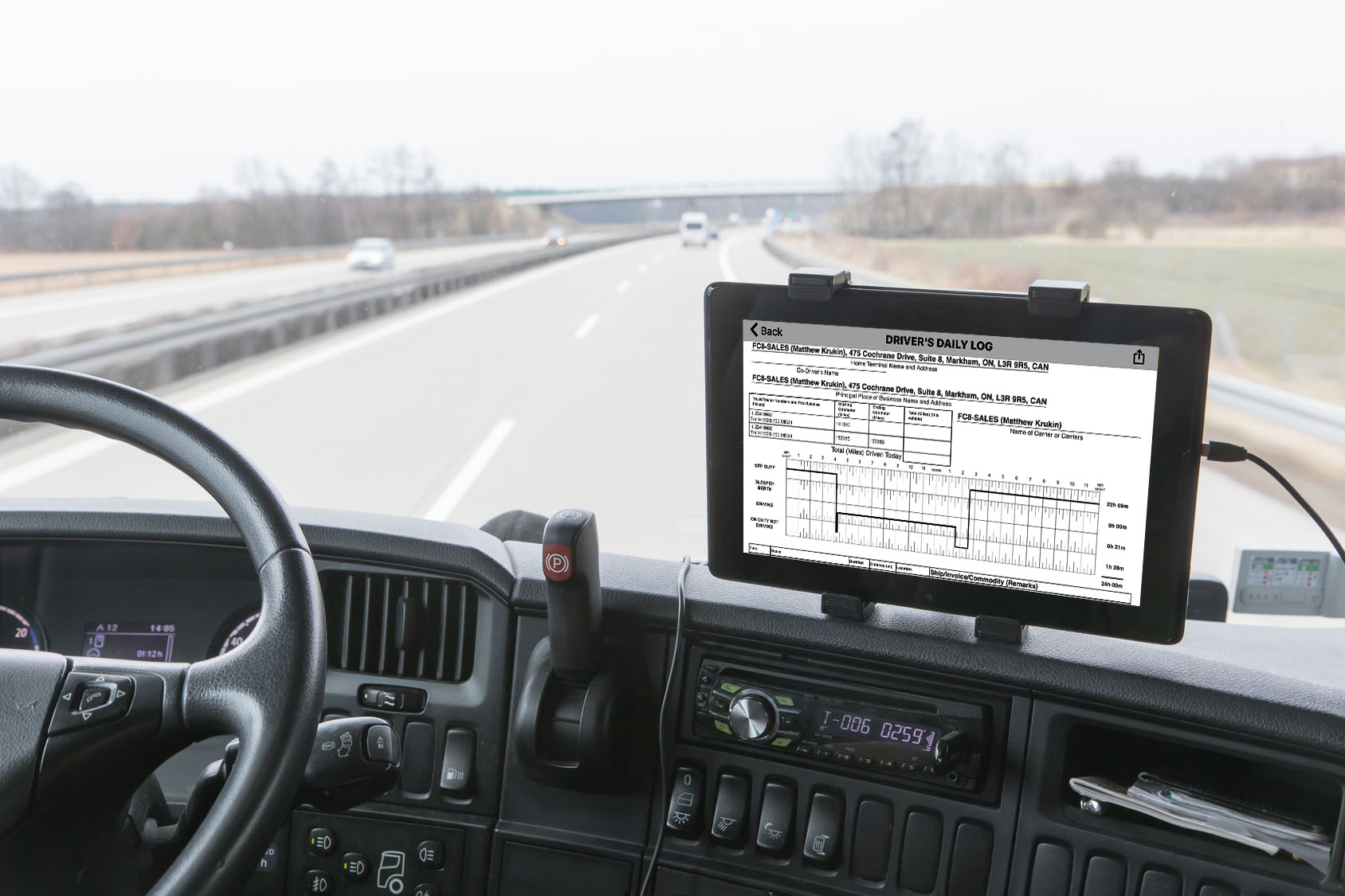As you will find, there are significant differences between the Sleeper Berth rules in Canada and in the U.S. Use the samples and FAQs below to familiarize yourself in more detail about the differences, which can be particularly useful for federal carriers traveling in teams in both countries.
Reference blog: U.S. Sleeper Berth Rules and examples
Canadian Sleeper Berth Rules:
-
Single drivers:
- Must take 10 hours off-duty, BUT
- May split the sleeper-berth time into 2 periods provided neither is less than 2 hours.
-
Team drivers:
- Must take 8 hours off-duty, BUT
- May split the sleeper-berth time into 2 periods provided neither is less than 4
-
Drivers using the Sleeper Berth provisions must still comply with “Daily Requirements”:
- Maximum of 13 hours driving
- No driving after 14 hours on-duty
- Minimum of 10 hours off-duty
-
No driving after accumulating (prior to and after the period):
- 13 hours driving
- 14 hours on-duty
- 16 hours in the work shift
-
Sleeper Berth must meet prescribed design standards to be considered as a Sleeper
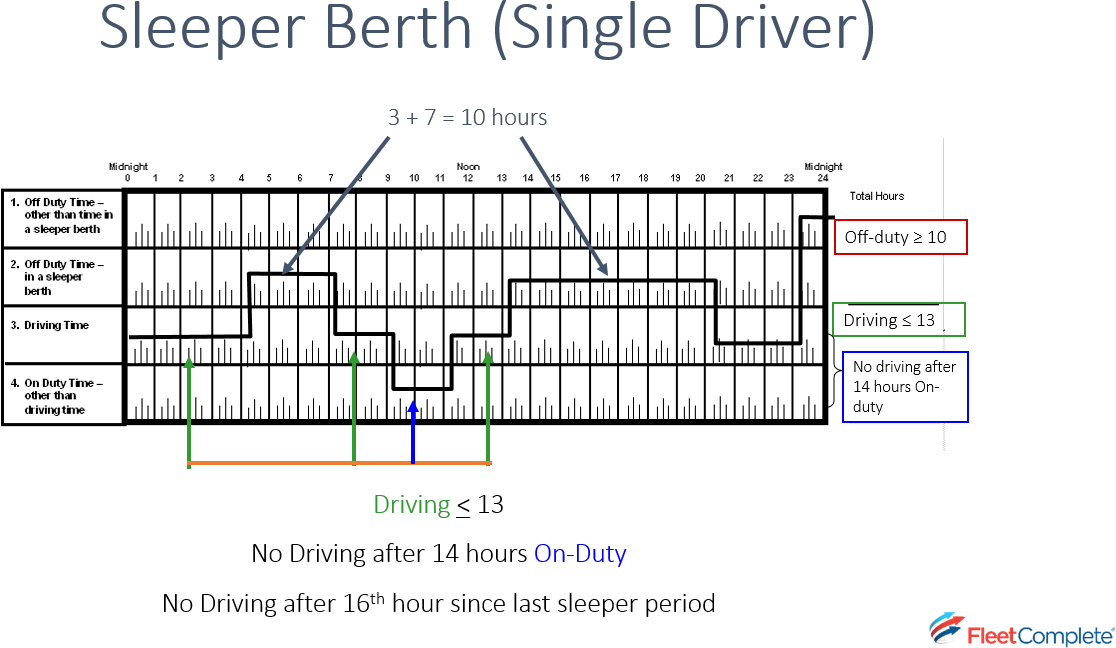
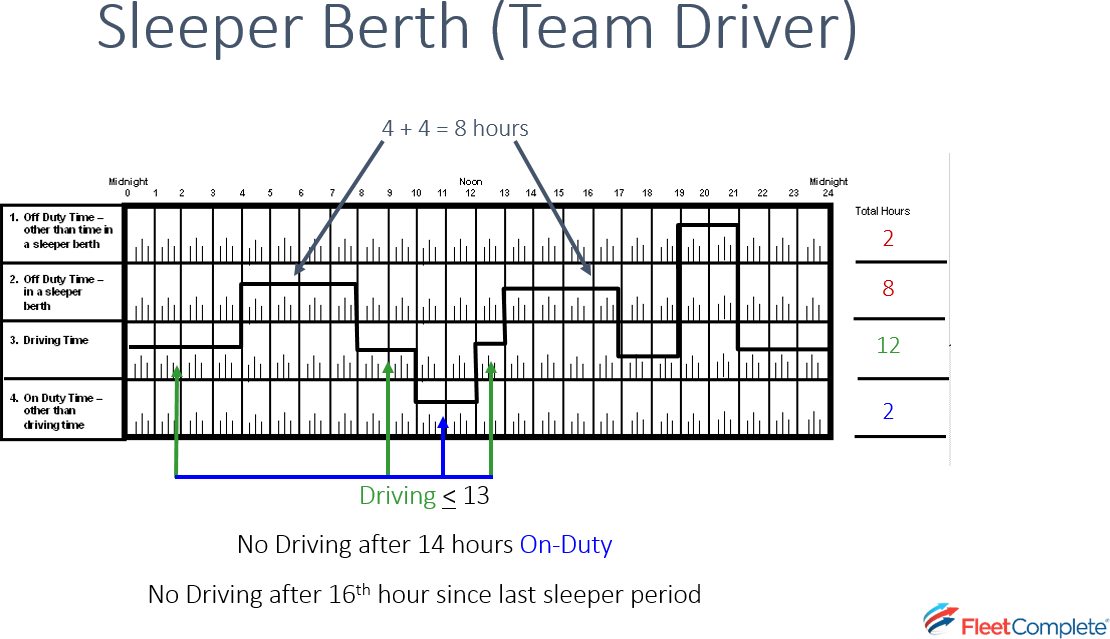
Cycles
-
Must Elect One & Confirm on Log!
- Cycle 1: 70 hours/7 days
- Cycle 2: 120 hours/14 days (must take 24 consecutive hours off-duty prior to 70th hour)
-
Cycle switching only allowed after completing required off-duty period
- Cycle 1: 36 hours (also reset)
- Cycle 2: 72 hours (also reset)

Questions and Answers
May a sleeper berth be used for a period of less than 2 hours’ duration?
Periods of time spent in a sleeper berth of less than 2 hours but greater than 30 minutes may be used to satisfy the daily 10 hours off-duty requirement (other 2 hours). However, this time cannot be credited towards the periods of time that must be spent in the sleeper berth to satisfy the splitting of the daily off-duty time.
Can a driver book off-duty during any extensive period of waiting?
If the driver is in the sleeper berth or is relieved by the motor carrier from responsibility for the vehicle and load and allowed to pursue personal activities.
Can time spent in sleeping facilities being transported as cargo (e.g., boats, campers, travel trailers) be recorded as sleeper berth time?
The sleeping facilities would not qualify as a sleeper berth as defined in Section 1 of the Regulations. Also, Sections 18 and 19 are specific to the type of commercial vehicle and the terms on which the rules are applied. Reference: Section 18(1) (c), Section 1 definition of “sleeper berth” and Schedule 1.
If a bus is not equipped with a sleeper berth, can the driver stretch out on the back seat to rest/sleep and claim sleeper berth time?
No.
A driver can drive for 13 consecutive hours following 8 consecutive hours off-duty. Can the driver also drive for 13 consecutive hours following 8 hours off-duty taken in 2 sleeper berth periods that have been separated by driving?
No.
Can the 8 consecutive off-duty hours be comprised of a combination of off-duty time and time spent in the sleeper birth?
Yes, provided the time is continuous.
How are the sleeper berth rules for single and team drivers applied?
Motor carriers and drivers must respect the requirements.
Example: Sleeper Berth – Single
Step 1: Rules for the days
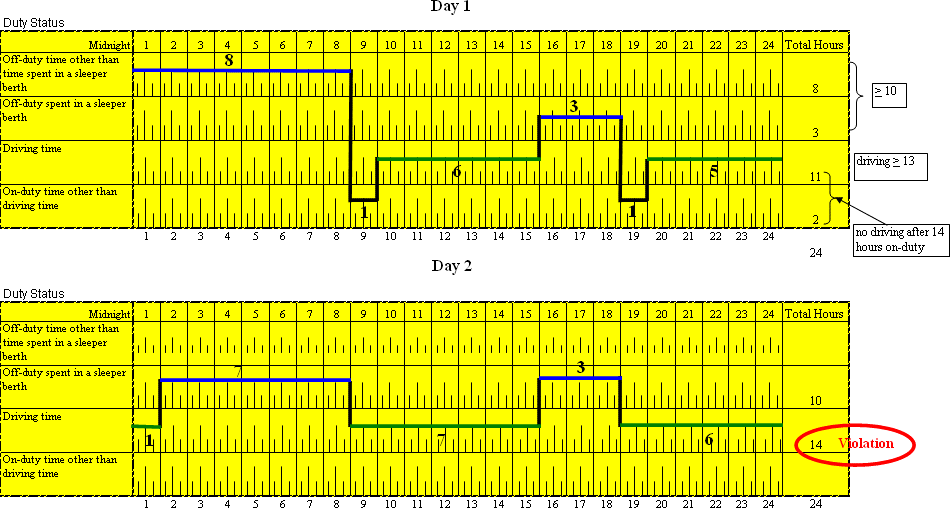
Violations:
-
Exceed 13 hours driving time
-
Identify sleeper berth rest periods
- neither period is shorter than 2 hours; and
- the total of the two periods is at least 10 hours (single driver)
Step 2: Rules for the work shift – Identify rest periods

A driver may not drive after having accumulated in the periods immediately before and after each of the period of off-duty time:
- 13 hours driving
- 14 hours on-duty
- 16 hours elapsed time
None of the daily off-duty time is deferred to the next day.
Step 3: Rules for the work shift – Verify driving times

Note: the 16th hour is calculated by:
-
Excluding the period spent in the sleeper berth that is 2 hours or more in duration and that, when added to a subsequent period in the sleeper berth, totals at least 10 hours; and
-
Including
- all on-duty time,
- all off-duty time not spent in the sleeper berth,
- all periods of less than 2 hours spent in the sleeper berth, and
- any other period spent in the sleeper berth that does not qualify as counting towards meeting the requirements of this Section.
Can a driver combine a consecutive sleeper berth rest period and an off-duty period to obtain 8 hours off-duty?
Yes. The driver may combine sleeper berth time and other off-duty time to meet the minimum 8 consecutive hours of off-duty time. The driver cannot combine sleeper berth time and other off-duty time to meet the minimum split sleeper berth requirements.
Do the Regulations allow drivers to switch from a team environment to a single driver and vice versa?
Yes, providing the driver records in the daily log when this occurred and complies with the requirements for the (team or single) situation in which they are now engaged.
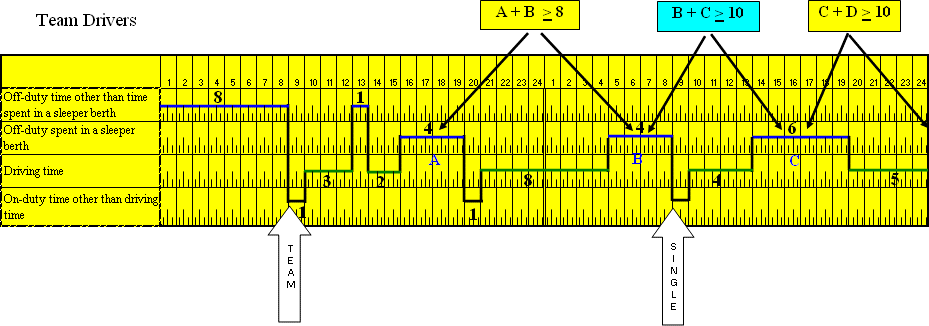
With regard to calculating the 16 hour rule for single drivers in utilizing the sleeper berth provisions (Section 18(2), if the driver takes two periods of off-duty in the sleeper berth, one being 2 hours and other being 8 hours, would the calculation of the 16 hour rule revert back to normal off-duty provisions under Section 13(3)?
Yes. Any period of at least 8 consecutive hours automatically resets the work shift.
If a commercial vehicle is not equipped with a sleeper berth, can a driver stop the vehicle and “make” a sleeper berth using the driver/passenger seat area and claim split sleeper berth?
No. A suitable sleeping accommodation must satisfy the specifications prescribed in Schedule 1 in order to be considered a sleeper berth.
How is the 16 hours of elapsed time reflected when using the sleeper berth provision?
The following illustration provides clarification. It is important to remember drivers are not allowed to drive a commercial vehicle after accumulating 16 hours during the work shift.
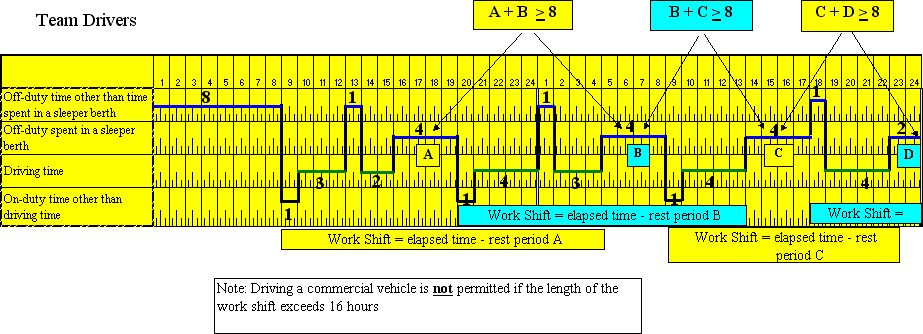
After accumulating 8 consecutive hours of off-duty time, a driver spends 3 hours in the sleeper The driver then drives a commercial vehicle for 13 hours, then spends 7 hours in the sleeper berth. Can the driver combine the two sleeper berth periods to meet the required 10 hours of off-duty time as per Section 18, and then drive for up to 13 more hours after the last 7 hours in the sleeper berth?
No, as the total of the driving time in the periods immediately before and after each of the sleeper berth periods cannot exceed 13 hours.
Cycles (Sections 24 – 27)
In Sections 26 and 27, what is meant by “during the period of the cycle that was ended”?
The period of time in a cycle can be less than 7 or 14 days. A cycle can reset at any time. If a driver has reset cycle 1 (70 hours/7 days) then a new cycle is opened and the first day of the cycle is the only day included in the elected cycle (cycle 1 or cycle 2). The duration of a cycle is less than 7 days or 14 days when a driver resets a cycle after less than 7 or 14 days. For example, the duration of a cycle could be only one day if the driver was off-duty for more than 36 hours, drives only one day, and takes 36 hours off-duty. In that case, the duration of the cycle is one day.
When does a “cycle” start? Does it start at 00:01 on the first day of the cycle or at the time the first work shift starts in the “cycle”?
It starts at the time determined by the motor carrier as the start time for the day. If a motor carrier has declared a start time for the day to be different than the calendar day, then the day starts at the declared time and stays at that time for the rest of the cycle.
Does a driver, employed full time by one motor carrier using cycle 1, (70-hours in 7-days), and part-time by another motor carrier using cycle 2, (120-hours in 14-days), have the option of using either rule in computing his hours of service?
No. The driver has the option of electing to work either on cycle 1 (70 hours in 7 days) or cycle 2 (120 hours in 14 days) and during this period the driver must adhere to that cycle. However, the motor carrier and /or driver has the option of switching cycles if he takes the following off-duty time: at least 36 hours off-duty for cycle 1; or at least 72 hours off-duty for cycle 2 (reset).
If a driver has elected cycle 1(70 hours/7 days) but reaches the 70 hours in only 5 days, how does he record the 36-hour continuous off-duty time?
Must be recorded as off-duty on the graph grid or in the record of duty status. See illustration.
Example 1:
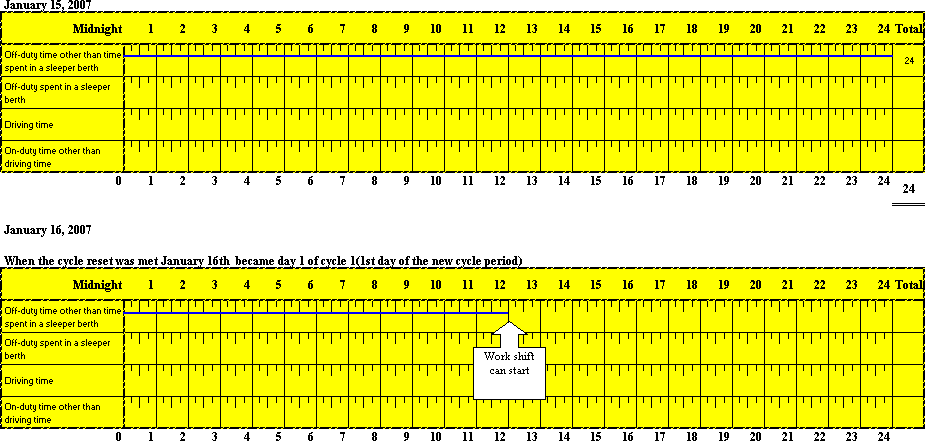
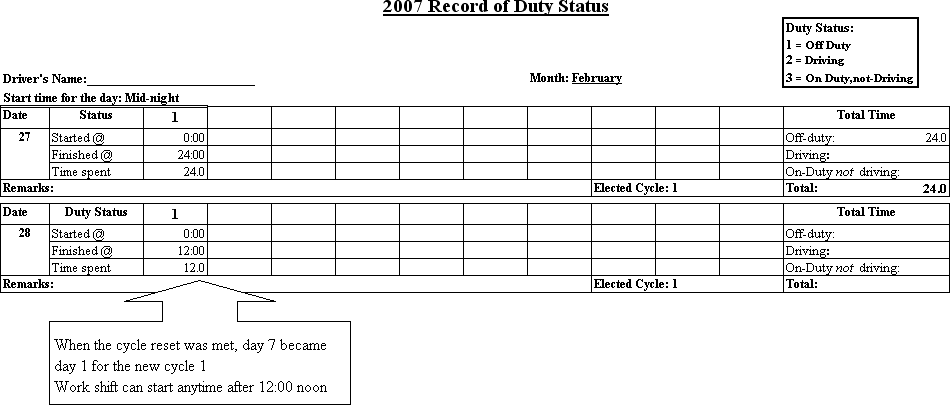
Is it a violation if a driver fails to declare the cycle that he/she is operating on, in the daily log?
Yes.
Can a driver combine off-duty and sleeper berth times to accumulate 24 consecutive hours off-duty time in order to either satisfy the requirement to have taken 24 consecutive hours off-duty within the previous 14 days or if following cycle 2, before exceeding 70 hours on- duty?
Yes.
Example 2: Illustration of Cycle 1 (70 hours / 7 days)
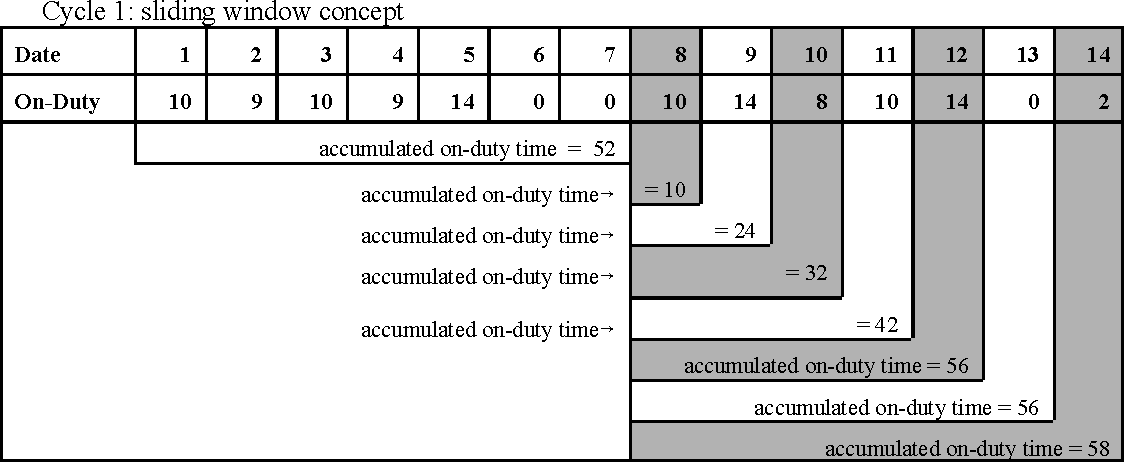
Example 3:
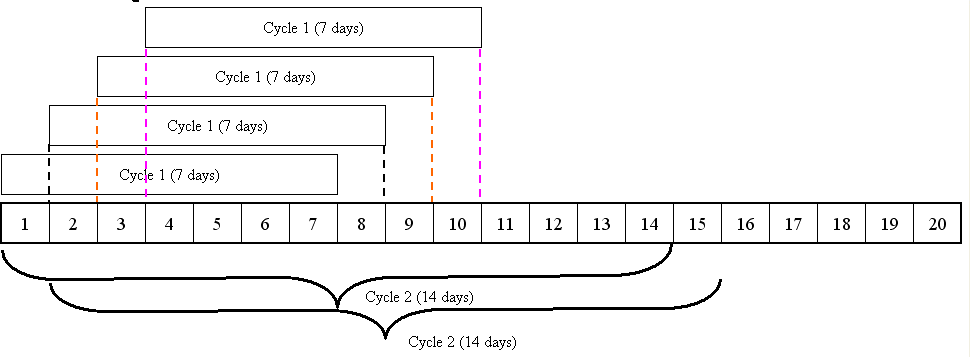
Who makes the decision as to which cycle a driver operates under?
The motor carrier and the driver. Reference: Section 24. Refer to the following three examples.
Example 1: A driver finishes a work shift at 15:00 on day 1, and the next work shift starts at 03:00 on day 3. The driver has had 36 hours off-duty and therefore can reset the cycle. Does the new cycle start at 00:01 on day 3?
Answer: The cycle starts at the commencement of the day for which the motor carrier has determined the start time. See illustration:
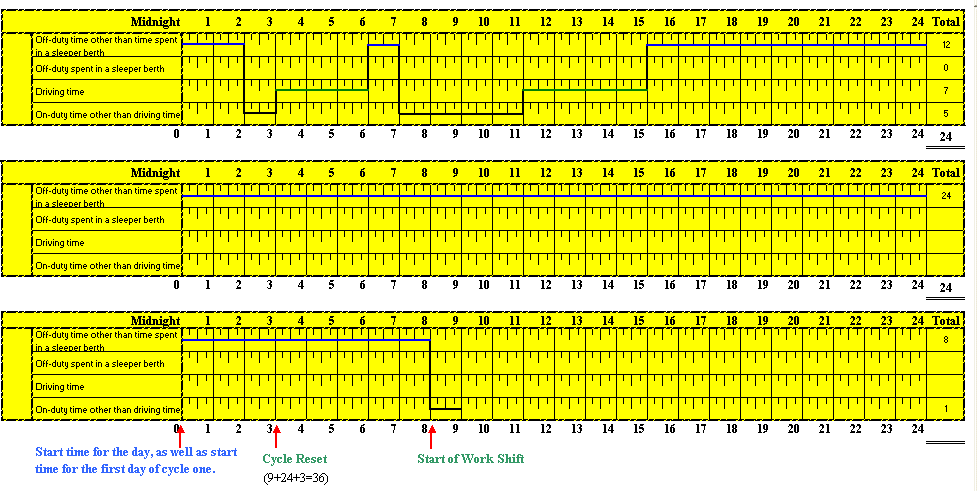
Example 2: A driver finishes a work shift at 03:00 on day 1, and the next work shift starts at 15:00 on day 2. The driver has had 36 hours off-duty and therefore can reset the cycle. Does the new cycle start at 00:01 on day 2?
Answer: Yes. See illustration.
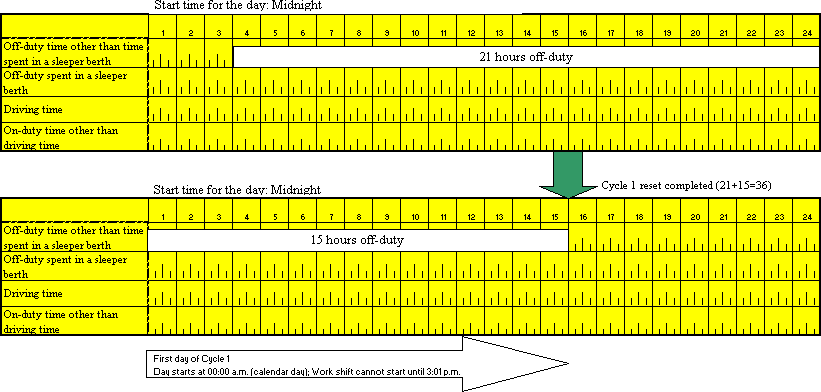
Example 3: A driver is operating under cycle 2 and finishes a work shift at 15:00 on day 1, and the next work shift starts at 15:00 on day 4. The driver has had 72 hours off-duty and therefore can reset to cycle 1. Does the new cycle 1 start at midnight on Day 4?
Answer: Yes, see illustration.
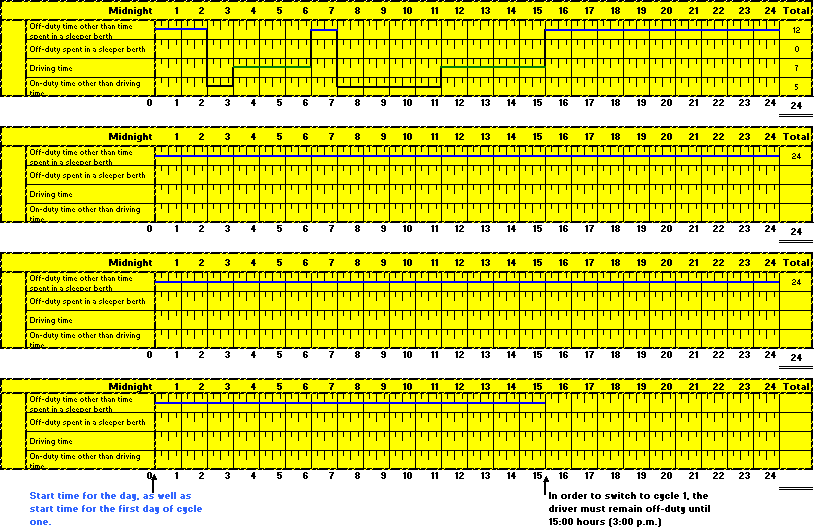
What is the procedure to switch from a calendar day to a 9:00 pm start? A driver received instructions from the motor carrier that he would no longer be working days, but would be working evenings starting Monday, January 8. In addition, his day would begin at 9:00 pm.
See illustration.
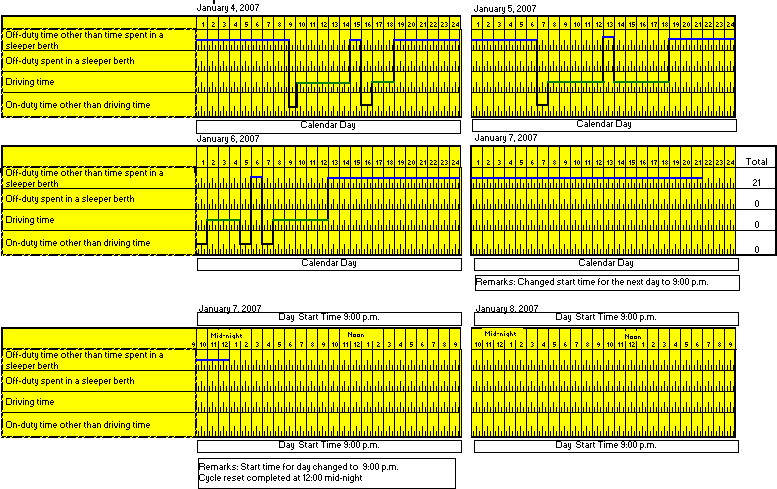
The above information is for informational purposes only, and should in no way be relied upon as legal advice.

About the Author: Marc Moncion
Marc is the Head of Safety, Compliance & Regulatory Affairs for Fleet Complete. Marc is an author and industry subject matter expert that has worked in numerous senior transportation management roles for over 25 years, including an Inspector for the MTO. Marc sits on several Federal/State/Provincial regulatory bodies, and frequently provides commentary on emerging technology, best practices and regulatory affairs. In addition, Marc is a commercial driver’s licence (CLD) holder, and can drive all types of commercial vehicles in North America.







































































